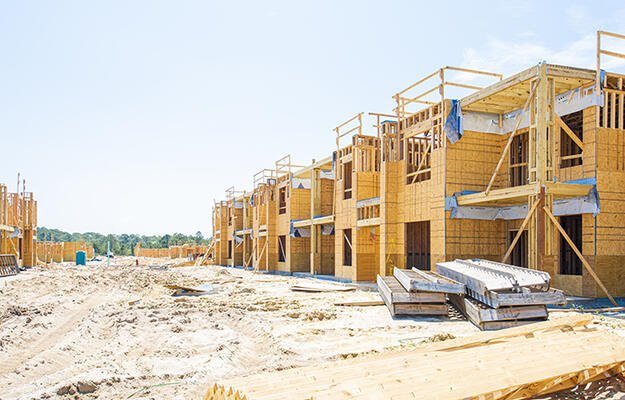
(SeventyFour/Shutterstock)
Why Housing and Education Stakeholders Are Natural Allies: A Q&A with Richard Kahlenberg
The Bayside/Little Neck and Jamaica/Hollis neighborhoods in Queens, New York, are located very close to one another but have very different zoning policies.
In Bayside/Little Neck, 57 percent of the region is zoned only for single-family detached housing, and in 2005, it tightened its zoning laws to limit new development. By contrast, just 12 percent of Jamaica/Hollis was zoned for single-family homes, and they’ve recently welcomed more transit-oriented development.
A recent Century Foundation report shows this results in very different local school outcomes. Test scores and graduation rates in Bayside/Little Neck are much higher than in Jamaica/Hollis. The report identifies ways housing development may influence school performance and why inclusionary zoning may help all students and calls for a two-pronged schooling and housing strategy.
Housing Matters spoke with the Richard Kahlenberg, the report’s author and a senior fellow at the Progressive Policy Institute, to learn more about the critical link between housing and equitable school access for all students. Kahlenberg is also the author of a forthcoming book, Excluded: How Snob Zoning, NIMBYism, and Class Bias Build the Walls We Don’t See (PublicAffairs Books, July 2023).
The interview has been lightly edited for length.
What is one thing you wish educators and school systems knew about the housing system or housing policy?
The key message of the report is that housing policy is school policy. Exclusionary housing policies that drive economic segregation of schools do terrible damage to the education of schoolchildren. So if you care about education, you need to pay attention to housing policies.
Many people know that the biggest predictor of academic achievement is the socioeconomic status of the family that a child is raised in. But they don’t always realize that the second biggest predictor is the socioeconomic status of her classmates. The report lays out the evidence that children from households with low incomes perform much better, on average, in economically mixed schools than in high-poverty schools. Moreover, students of all economic backgrounds benefit from attending economically and racially diverse schools.
Because most school children attend neighborhood public schools, exclusionary housing policies that keep families of modest means out of high-performing public school districts thwart opportunity for low-income and working-class students, many of them students of color. In this sense, exclusionary zoning is a linchpin in the architectural design of educational inequality in America. Educators, therefore, should become engaged in the housing reform debates that are percolating across the country.
What do you wish housing developers and housing advocates knew about school segregation and school inequality?
I think it’s critical that housing developers and advocates realize that—for the reasons outlined above—they have an enormous role to play in deciding whether public education can succeed in delivering on its promise of being the great equalizer.
Most of the debates over housing and zoning reform in recent years have understandably focused on housing affordability. It is true that we need to dismantle exclusionary zoning laws because they limit supply and artificially drive up housing prices. It is also true that these exclusionary laws are bad for the environment because they promote urban sprawl, which means longer commutes in cars. Those arguments were prominent in efforts to reform zoning laws in California, Oregon, Minneapolis, and elsewhere. But I think sometimes underappreciated are the ways in which exclusionary zoning drives educational inequality in America. I think it’s incredibly important for housing advocates who support zoning reform to enlist education allies in the fight for change.
The report notes that it’s not inevitable that students from families with low incomes will perform at low academic levels, but people tend to correlate income with educational outcomes. Does this report provide any insight into what types of schools or school resources may promote growth?
The research suggests that low-income students can perform at much higher levels if they have the chance to attend economically mixed, rather than high-poverty, schools. That matters even more than school spending.
In the report, I cite evidence from an important 2010 study of two strategies in Montgomery County, Maryland, conducted by Heather Schwartz of the RAND corporation. In the first strategy, the school board invested $2,000 extra per pupil in higher-poverty schools designated as part of the county’s “red zone.” In the second strategy, housing officials employed an “inclusionary zoning” program in the “green zone” that required developers to set aside some new units throughout the county for families with low incomes and provided that some would become made available for public housing. Because public housing is scarce, families on a waitlist almost always take whatever unit becomes available, so the study effectively involved random assignment families with low-incomes.
Schwartz examined the performance of 850 elementary school students living in public housing (72 percent of whom were Black, 16 percent Hispanic, 6 percent Asian, and 6 percent white) to determine if students with lower incomes living in public housing performed better in red zone schools that invested extra funds or green zone schools that did not receive extra funding because they were in more affluent areas.
She found that over time, economic integration was a far more effective strategy than compensatory spending. In the green zone, disadvantaged students performed much better and cut the math achievement gap with their middle-class peers in half between 2001 and 2007, and by one-third in reading. In other words, what the housing authority did for students had a bigger impact than what the school board did.
The report begins with the debate over housing reform in New York State. After reviewing all their plans, what do you think we’re most likely to see change in the next two to three years?
To my mind, the fundamental housing question in the coming years is whether we continue to allow local communities, through their zoning laws, to play such an enormous role in dictating who gets to live where, and whose kids get access to high-performing public schools. Government zoning policies drive economic and racial segregation at least as much as consumer preference and the marketplace for homes. It is possible to build housing that is affordable, even in wealthy communities that have expensive land values, by building multiple smaller units on a given plot of land. Doing so divides the cost of the land between several parties, and shared walls reduce construction costs per housing unit.
But zoning laws in many communities outlaw multifamily housing. An important 2010 study of 50 metropolitan areas found that “a change in permitted zoning from the most restrictive to the least would close 50 percent of the observed gap between the most unequal metropolitan area and the least, in terms of neighborhood inequality.”
The politics of zoning reform can be tough. We just saw that in New York State, where the legislature rejected an ambitious proposal to require localities to permit more housing, and if they didn’t, to set up a fast-track state approval process. But I’m encouraged that in many places, NIMBY forces have been defeated. Minneapolis, Charlotte, Arlington (Virginia), California, Oregon, Washington, Arkansas, Utah, and Montana have all seen tremendous progress to reduce exclusionary zoning. My hope is that efforts to tear down the exclusionary “walls we don’t see” will multiply in the next two to three years. That would be good for housing costs. It would be good for the environment. And, as the report on Queens suggests, it would be good for educational opportunity as well.


